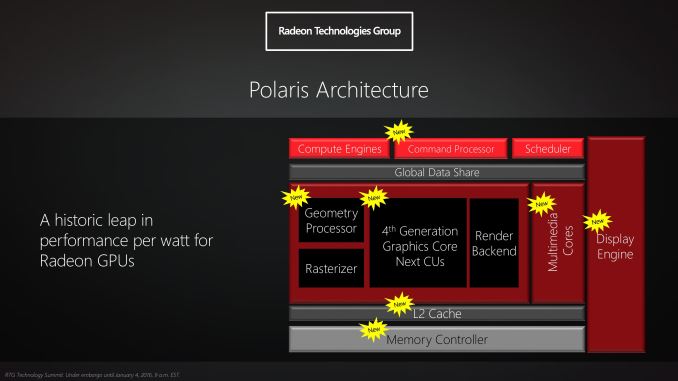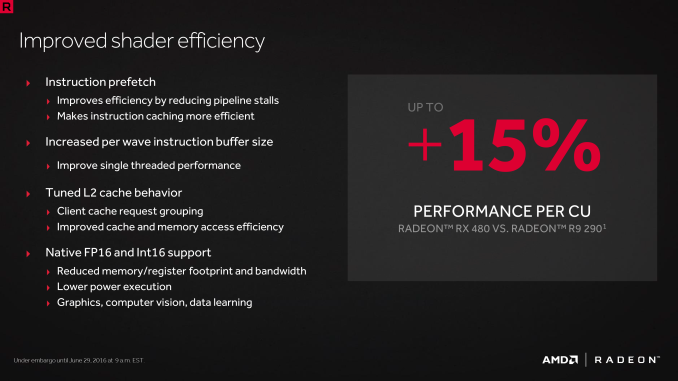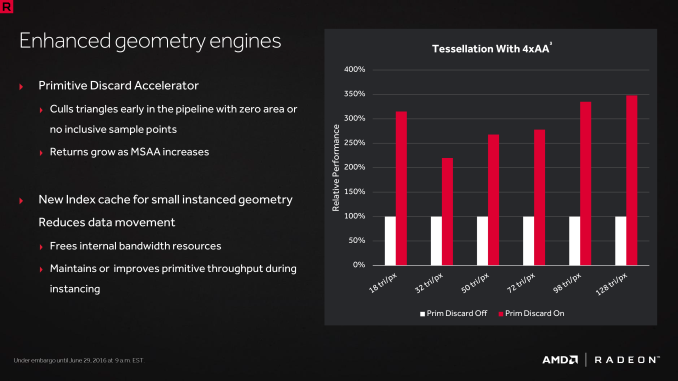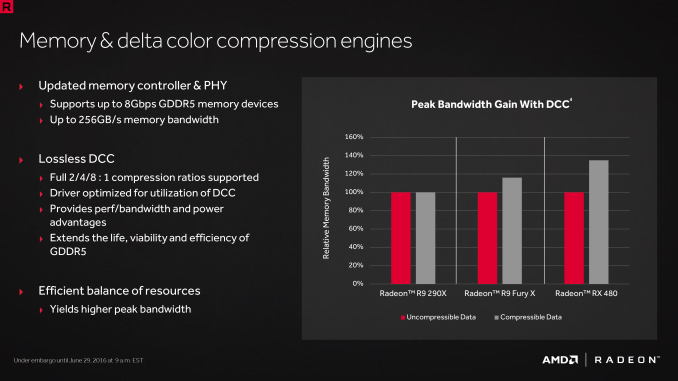The AMD Radeon RX 480 Preview: Polaris Makes Its Mainstream Mark
by Ryan Smith on June 29, 2016 9:00 AM ESTThe Polaris Architecture: In Brief
For today’s preview I’m going to quickly hit the highlights of the Polaris architecture.
In their announcement of the architecture this year, AMD laid out a basic overview of what components of the GPU would see major updates with Polaris. Polaris is not a complete overhaul of past AMD designs, but AMD has combined targeted performance upgrades with a chip-wide energy efficiency upgrade. As a result Polaris is a mix of old and new, and a lot more efficient in the process.
At its heart, Polaris is based on AMD’s 4th generation Graphics Core Next architecture (GCN 4). GCN 4 is not significantly different than GCN 1.2 (Tonga/Fiji), and in fact GCN 4’s ISA is identical to that of GCN 1.2’s. So everything we see here today comes not from broad, architectural changes, but from low-level microarchitectural changes that improve how instructions execute under the hood.
Overall AMD is claiming that GCN 4 (via RX 480) offers a 15% improvement in shader efficiency over GCN 1.1 (R9 290). This comes from two changes; instruction prefetching and a larger instruction buffer. In the case of the former, GCN 4 can, with the driver’s assistance, attempt to pre-fetch future instructions, something GCN 1.x could not do. When done correctly, this reduces/eliminates the need for a wave to stall to wait on an instruction fetch, keeping the CU fed and active more often. Meanwhile the per-wave instruction buffer (which is separate from the register file) has been increased from 12 DWORDs to 16 DWORDs, allowing more instructions to be buffered and, according to AMD, improving single-threaded performance.
Outside of the shader cores themselves, AMD has also made enhancements to the graphics front-end for Polaris. AMD’s latest architecture integrates what AMD calls a Primative Discard Accelerator. True to its name, the job of the discard accelerator is to remove (cull) triangles that are too small to be used, and to do so early enough in the rendering pipeline that the rest of the GPU is spared from having to deal with these unnecessary triangles. Degenerate triangles are culled before they even hit the vertex shader, while small triangles culled a bit later, after the vertex shader but before they hit the rasterizer. There’s no visual quality impact to this (only triangles that can’t be seen/rendered are culled), and as claimed by AMD, the benefits of the discard accelerator increase with MSAA levels, as MSAA otherwise exacerbates the small triangle problem.
Along these lines, Polaris also implements a new index cache, again meant to improve geometry performance. The index cache is designed specifically to accelerate geometry instancing performance, allowing small instanced geometry to stay close by in the cache, avoiding the power and bandwidth costs of shuffling this data around to other caches and VRAM.
Finally, at the back-end of the GPU, the ROP/L2/Memory controller partitions have also received their own updates. Chief among these is that Polaris implements the next generation of AMD’s delta color compression technology, which uses pattern matching to reduce the size and resulting memory bandwidth needs of frame buffers and render targets. As a result of this compression, color compression results in a de facto increase in available memory bandwidth and decrease in power consumption, at least so long as buffer is compressible. With Polaris, AMD supports a larger pattern library to better compress more buffers more often, improving on GCN 1.2 color compression by around 17%.
Otherwise we’ve already covered the increased L2 cache size, which is now at 2MB. Paired with this is AMD’s latest generation memory controller, which can now officially go to 8Gbps, and even a bit more than that when oveclocking.














449 Comments
View All Comments
warreo - Wednesday, June 29, 2016 - link
Who said the 1060 will be $330+? Source?If it follows the previous gen's price differential to the 1070, it will be priced at $250...your argument is even more absurd and biased than webdoctors'. Pipe down.
K_Space - Wednesday, June 29, 2016 - link
You're both "right" in inverted commas because we don't have hard facts yet. But if you believe the green leaning WCCFtech, the GTX 1060 will launch at $250:http://wccftech.com/nvidia-gtx-1060-special-launch...
As its rumoured to launch with 3Gb and 6Gb, I suspect these will come in $199 and $250 respectively. 3Gb strikes me as quite low, not sure if it'll affect 1080p performance though. Either way, potential gamers will see 3Gb versus 4Gb and grab the 480 (ditto for the bigger versions).
TL;DR I doubt the 1060 will "wipe the 480 out of the landscape"
fanofanand - Thursday, June 30, 2016 - link
The 1060 3 Gb being $199 is awfully optimistic. Nvidia is like Intel, they REALLY like their profit margins.D. Lister - Wednesday, June 29, 2016 - link
In the 480's defense, it offers GTX 970+ performance (esp. In dx 12), plus an extra 4GB of VRAM, while consuming less power. If both were OCed, the 970 would probably beat it in most benches, but c'mon, it is a mainstream product, and most people who already have a 970, paid much higher than what it goes for now.smilingcrow - Wednesday, June 29, 2016 - link
The 480 consumes slightly less when gaming but a lot more at idle so overall I'd say it loses in terms of power efficiency. Good value all the same.just4U - Wednesday, June 29, 2016 - link
Wouldn't this new process have a ton more overclocking headroom than 28mm?D. Lister - Thursday, June 30, 2016 - link
Well, you get what you pay for. Think of the 480 as a fully factory-overclocked GPU, that is for people who haven't even heard of overclocking, but want to play modern games at 1080p/60FPS, while having to pay the minimum for that tier of performance.Eden-K121D - Wednesday, June 29, 2016 - link
Overhyped shitty card by AMD.What a brilliant F**K up by AMDD. Lister - Wednesday, June 29, 2016 - link
C'mon now, they told everyone well in advance that it would be ~$200 and target the mainstream. For that, it offers extremely reasonable performance. If you were expecting a 1070-beater for $200 then, with all due respect, the problem is with your expectations, and not this product.Notmyusualid - Wednesday, June 29, 2016 - link
Indeed.Haters are just gonna hate.